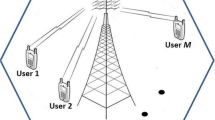Abstract
A design of closed-loop grouped space–time block codes (G-STBCs) including encoding, decoding and codeword selection is proposed for the downlink over Rayleigh flat-fading channels. In particular, at the transmitter, the antenna array is partitioned into a number of groups, each of which is encoded based on the orthogonal STBC (O-STBC). At the receiver, by exploiting the algebraic structure of orthogonal codes, a low-complexity, in recursion form, group-wise ordered successive interference cancellation (OSIC) detector is developed. Moreover, the G-STBC codeword is designed and a G-STBC codeword selection criterion that minimizes the BER performance under the constraints of a fixed spectral efficiency and total transmit power is then proposed. The selection index of the G-STBC codeword and the associated modulation type are determined at the receiver and conveyed to the transmitter with a limited feedback overhead to choose an appropriate mode for transmission. Finally, Numerical examples are used for illustrating the performance of the proposed G-STBCs, OSIC based detection and G-STBC codeword selection criterion.
Similar content being viewed by others
References
3GPP TR 25.814. (2006). Physical layer aspects for evolved UTRA (Release 7). Release 7, v. 7.0.0.
IEEE 802.16e Std. (2006). IEEE standard for local and metropolitan area networks Part 16: Air interface for fixed and mobile broadband wireless access systems amendment 2: Physical and medium access control layers for combined fixed and mobile operation in licensed bands and corrigendum 1. IEEE Std 802.16e-2005 and IEEE Std 802.16-2004/Cor 1-2005.
Gesbert D., Shafi M., Shiu D., Smith P.J., Naguib A. (2003). From theory to practice: An overview of MIMO space-time coded wireless systems. IEEE Journal of Select on Areas in Communication 21(3): 281–302
Paulraj A.J., Gore D.A., Nabar R.U., Bölcskei H. (2004). An overview of MIMO communications—A key to gigabit wireless. Proceedings of the IEEE 92(2): 198–218
Diggavi S.N., Al-Dhahir N., Stamoulis A., Calderbank A.R. (2004). An great expectations: The value of spatial diversity in wireless networks. Proceedings of the IEEE 92(2): 219–270
Paulraj A.J., Papadias C.B. (1997). Space-time processing for wireless communications. IEEE Signal Processing Magazine 14(11): 49–83
Paulraj, A. J., Nabar, R., & Gore, D. (2003). Introduction to space-time wireless communications. Cambridge University Press.
Foschini G.J. (1996). Layered space-time architecture for wireless communication in a fading environment when using multi-element antennas. Bell Laboratories Technical Journal. 1: 45–49
Foschini G.J., Gans M.J. (1998). On limits of wireless communications in a fading environment when using multiple antennas. Wireless Personal Communications 6(3): 311–335
Golden G.D., Foschini G.J., Valenzuela R.A., Wolniansky P.W. (1999). Detection algorithm and initial laboratory results using V-BLAST space-time communication structure. Electronic Letters 35(1): 14–16
Tarokh V., Seshadri N., Calderbank A.R. (1998). Space-time codes for high data rate wireless communication: Performance criterion and code construction. IEEE Transactions on Information Theory 44(2): 744–765
Alamouti S. (1998). A simple transmit diversity scheme for wireless communications. IEEE Journal on Selected Areas in Communications 16(8): 1451–1458
Tarokh V., Jafarkhani H., Calderbank A.R. (1999). Space-time block codes from orthogonal designs. IEEE Transactions on Information Theory 45(7): 1456–1467
Larsson, E. G., Stoica, P. (2003). Space-time block coding for wireless communications. Cambridge University Press.
Zheng L., Tse D.N.C. (2003). Diversity and multiplexing: A fundamental tradeoff in multiple-antenna channels. IEEE Transactions on Information Theory 49(5): 1073–1096
Proakis, J. G. (2001). Digital communications, (4th edn.). The McGraw-Hill Companies, Inc.
Gesbert D., Haumonte L., Bolcskei H., Krishnamoorthy R., Paulraj A.J. (2002). Technologies and performance for non-line-of-sight broadband wireless access network. IEEE Communications Magazine 40(4): 86–95
Kim I.M., Tarokh V. (2001). Variable-rate space-time block codes in M-ary PSK systems. IEEE Journal on Selected Areas in Communications 21(3): 362–373
Naguib, A. F., Seshadri, N., & Calderbank, A. R. (1998). Applications of space-time block codes and interference suppression for high capacity and high data rate wireless systems. Proceedings of the IEEE 32th Asilomar Conference on Signals, Systems, and Computers, Vol. 2, pp. 1803–1810, Nov. 1998.
Stamoulis, A., Al-Dhahir, N., & Calderbank, A. R. (2001). Further results on interference cancellation and space-time block codes. Proceedings of the IEEE 35th Asilomar Conference on Signals, Systems, and Computers, Vol. 1, Nov. 2001, pp. 257–261.
Tarokh V., Naguib A., Seshadri N., Calderbank A.R. (1999). Combined array processing and space-time coding. IEEE Transactions an Information Theory 45(4): 1121–1128
Tao M., Chen R.S. (2004). Generalized layered space-time codes for high data rate wireless communications. IEEE Transactions on Wireless Communications 3(4): 1067–1075
Dai Y., Lei Z., Sun S. (2004). Ordered array processing for space-time coded systems. IEEE Communications Letters 8(8): 526–528
Ho, C. L., Wu, J. Y., & Lee, T. S. (2004). Block-based symbol detection for high rate space-time coded systems. Proceedings of the IEEE VTC 2004-Spring, Vol. 1, May 2004, pp. 375–379.
Ho C.L., Wu J.Y., Lee T.S. (2006). Group-wise V-BLAST detection in multiuser space-time dual-signaling wireless systems. IEEE Transactions an Wireless Communications 5(7): 1896–1909
Wu J.Y., Ho C.L., Lee T.S. (2006). Detection of multiuser orthogonal space-time block coded signal via ordered successive interference cancellation. IEEE Transactions an Wireless Communications 5(7): 1594–1600
Catreux S., Gesbert D., Heath R.W. (2002). Adaptive modulation and MIMO coding for broadband wireless data networks. IEEE Communications Magazine 40(6): 108–115
Chung S.T., Goldsmith A.J. (2001). Degree of freedom in adaptive modulation: A unified view. IEEE Transactions an Communications 49(9): 1561–1571
Tirkkonen, O., Boariu, A., & Hottinen, A. (2002). Minimum ono-orthogonality rate 1 space-time block code for 3+ Tx. IEEE ISSSTA 2002, pp. 429–432.
Author information
Authors and Affiliations
Corresponding author
Rights and permissions
About this article
Cite this article
Ho, CL., Tseng, FS. & Lee, TS. Closed-loop Grouped Space–Time Block Code: Encoding, Decoding and Codeword Selection. Wireless Pers Commun 44, 423–453 (2008). https://doi.org/10.1007/s11277-007-9366-0
Received:
Accepted:
Published:
Issue Date:
DOI: https://doi.org/10.1007/s11277-007-9366-0




